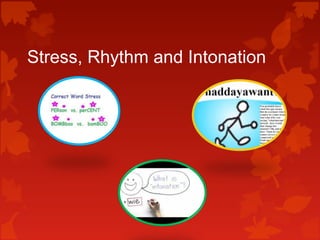Stress, rhythm and intonation
- 1. Stress, Rhythm and Intonation
- 2. Description Phonetics 290 B is a course that reinforces the knowledge acquired in Ingl├®s 290 A and introduces the vowel sounds of the English language. This course will be developed in modules which let you learn it more effectively. The module 1 is focus on vocal features known as stress, rhythm and intonation. These features will be practiced and analyzed to appreciate the differences in meaning they can cause. First of all the classes will begin with questioning and brainstorming about what the students know about the features. Second, the students will read and analyzed given information as well as conversations they will hear and ŌĆ£guessŌĆØ or ŌĆ£interpretŌĆØ the meaning of same sentences but pronounced in different ways because of the features. This way the students will appreciate how these features can convey different meanings clearly even though they are the same written sentences. The students will also compare similarities and differences between English and Spanish by using these features. At the end of the module the student will be able to distinguish the differences between these three features and their importance.
- 3. Objectives - To study the importance of stress, rhythm and intonation to acquire a good pronunciation in English. - To appreciate how stress, rhythm and intonation change the meaning of a word, sentence, message, etc. - To analyze situations in which the meaning of a word or message has changed because of the vocal features (stress, rhythm and intonation).
- 4. What is stress? Stress is the first vocal feature to be analyzed. Speakers must stress some syllables in words. If they do not do it, the words will be misunderstood or sound strange. Stress is used in Spanish. Stress also occurs in English. ŌĆ£P├®rmitŌĆØ is different from ŌĆ£perm├ŁtŌĆØ. ŌĆ£Her friend will pres├®nt you with a pr├®sent.ŌĆØ ŌĆ£I wonŌĆÖt clean the GARDEN.ŌĆØ implies a meaning different from ŌĆ£I wonŌĆÖt CLEAN the garden.ŌĆØ In other words, stress refers to the amount of volume that a speaker gives to a particular sound, syllable, or word while saying it. Stressed sounds and syllables are louder and longer than unstressed ones.
- 5. What is stress? The words accent, stress and emphasis are frequently used interchangeably. A major characteristic of the English language is the use of strong and weak stress. Every word or more than one syllable has a syllable that is emphasized more than the others. Accented syllables receive more force and are louder than an unaccented ones. Correct use of stress is essential for achieving proper pronunciation of words.
- 6. WhatŌĆÖs rhythm? Rhythm is the second feature to be studied. Rhythm is made by the strong stresses or beats in a sentence. In English syllables can be reduced by rhythm. For example, ŌĆ£ham and eggsŌĆØ is squeezed into two words: hamŌĆÖn eggs: ŌĆ£I want to beŌĆØ into I wanna be; ŌĆ£got youŌĆØ ŌĆ” gotcha. The five words ŌĆ£I will see you tomorrowŌĆØ may be pronounced ŌĆ£IŌĆÖllseeya tŌĆÖmorrowŌĆØ.
- 7. What is intonation? Intonation is the responsible for the melody of the language. Speakers frequently depend more on the intonation patterns to convey their meaning than on the pronunciation of the individual vowels and consonants. English Intonation is often the same as Spanish. ŌĆ£You speak English. If your voice falls you are making a statement. If your voice rises you are making a question. So itŌĆÖs not WHAT you say; itŌĆÖs HOW you say it! Although your English grammar might be very well and you can pronounce individual sounds correctly, you will still have your particular foreign accent if you do not master the stress, rhythm and intonation patterns of English.






